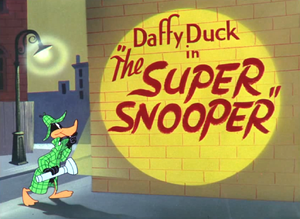The Super Snooper
| The Super Snooper | |
|---|---|
| Production company | Warner Bros. Cartoons |
| Distributor | Warner Bros. Pictures The Vitaphone Corporation |
| Release date | November 1, 1952 |
| Starring | Mel Blanc Grace Lenard |
| Producer(s) | Edward Selzer |
| Music composition | Carl Stalling |
| Story | Tedd Pierce |
| Animation | Herman Cohen Rod Scribner Phil DeLara Charles McKimson |
| Director(s) | Robert McKimson |
| Series navigation | |
| ← Previous | Next → |
| Title card | |

| |
The Super Snooper is the three hundred and sixth Looney Tunes theatrical short. It was distributed by Warner Bros. Pictures and The Vitaphone Corporation on November 1, 1952. It was written by Tedd Pierce, produced by Edward Selzer, and directed by Robert McKimson.
Daffy Duck plays hard-boiled detective, Duck Drake, who is summoned to the J. Cleaver Axe-Handle Estate where a terrible crime has been committed. But when he gets there, he suspects a shapely, femme fatale of a female duck to be the prime culprit.
Detailed summary
Memorable quotes
Characters
In order of appearance: | ||||||||||
| ||||||||||
Locations
- Earth
- United States
- Duck Drake's office
- Mansion
- United States
Objects
- Gun pistol
- Hunter's rifle
- Piano
Vehicles
- Train
Production
Development
Filming
It was copyrighted in 1951 (MCMLI).
Music
The score was composed by Carl W. Stalling.
The music heard during the opening credits is reused from The Hare-Brained Hypnotist and Hair-Raising Hare, and was reused once more in Hyde and Hare.
Crew Credits
- Layouts: Robert Givens
- Backgrounds: Richard H. Thomas
Release
Dates are in order of release:
- United States: November 1, 1952 in theatres
Behind the scenes
- The title is a pun on "super sleuther." You're welcome.
- The cartoon's premise is a parody of detective film noir films of the 1930s to 1950s.
- Daffy's detective alias, "Duck Drake," is obviously a reference to the fact that drakes are male ducks, and Daffy is a male duck.
- The lady duck has a physical resemblance to Melissa Duck, but is not the same character.
- In the opening scene, an office with the name "R. Givens" written on it appears in the background, a reference to Robert Givens.
- The engine on the train is a 4-6-0 engine (four leading wheels, six driving wheels, and no trailing wheels). In the mid-19th century, this wheel arrangement became the second most popular configuration for new steam locomotives in the United States. This type of engine is commonly referred to as a ten-wheeler.
- This is the final original Looney Tunes short to retain its original titles with a Daffy Duck headshot. It is also the only Daffy Duck short with the blue rings and red backgrounds to have this effect.
- This is also the last cartoon to have a mugshot of a character other than Bugs Bunny.
- This short reuses a piano gag from Canned Feud.
Errors
- When the lady duck fires the revolver, she holds the trigger but multiple shots are heard, despite the fact that a revolver can only fire repeatedly by releasing and pulling the trigger.
Legacy
- This short was used in the Valentine's Day television special Bugs Bunny's Cupid Capers.
Critical reception
In other languages
| Language | Name | Meaning |
|---|---|---|
Home availability
- In the United States:
- October 30, 2007: Warner Home Video releases Looney Tunes Golden Collection: Volume 5 on DVD.